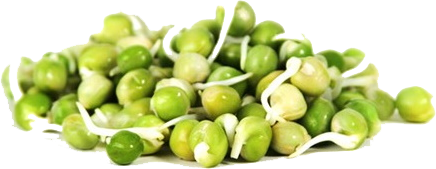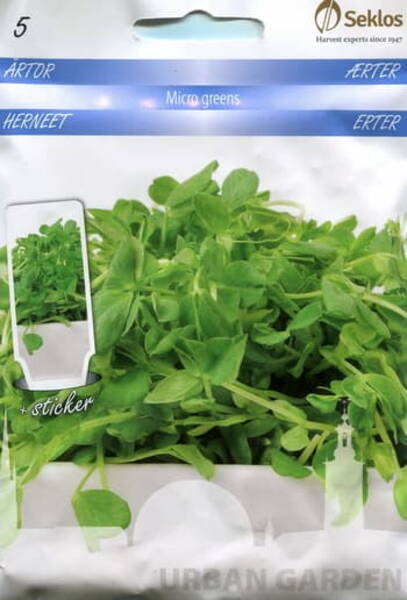Peas (seeds for germination). Microgreens.
Peas are a traditional natural product, the sprouted seeds of which have a surprisingly delicate taste, reminiscent of fresh green peas: they go especially well with pasta and rice.
Sprouted peas are easily absorbed by the body (unlike regular peas, without causing excessive gas formation).
Easily cultivated and rapidly growing sprouts – a source of vitamins. Fresh sprouts are used for food, can be used in a mix with other salads, but also are delicious alone.
Juicy and crispy, mildly tasting young sprouts. Sprouts appear 4–7 days after sowing. Before sowing seeds should be soaked for 12 hours at room temperature.
The seeds should be sown in a special medium or ecological substrate.
* Pea seeds have a high germination rate and contain vitamins B, E, C, K, PP, amino acids, fiber, saturated fatty acids and various minerals. Young pea sprouts are easily digestible and do not cause flatulence, unlike fruits.

Pea microgreens are a valuable source of protein substances containing such useful amino acids as cystine, lysine, arginine, tryptophan, methionine. In addition, it is rich in fiber and contains many vitamins B1, B2, C and minerals, including zinc, phosphorus, manganese, iron, potassium, calcium, copper and magnesium. At the initial stage of development, pea sprouts contain the greatest number of useful substances, including vitamins, amino acids and micro- and macroelements. In fact, the amount of useful substances in pea microgreens is tens of times higher than their content in ripe peas. The protein and fiber contained in it help suppress hunger centers in the brain and cause a feeling of satiety, which can be used for weight loss. Also, the proteins contained in peas can replace almost all essential amino acids that are usually found in animal food. Rich in vitamin C, peas strengthen the body's immune system by stimulating the proliferation of immune system cells and improving the recognition of foreign agents for their destruction.
The content of vitamin C, flavonoids, carotenoids and other biologically active substances in microgreens helps to normalize blood cholesterol levels. It also has antitumor activity due to the presence of many antioxidants that fight inflammation in the body and prevent the occurrence of malignant neoplasms. The fiber contained in it is necessary for the nutrition of beneficial microorganisms and helps to normalize the microflora.
You should not eat pea microgreens if you have:
• a tendency to allergies;
• kidney and urinary tract diseases in the acute stage;
• diabetes;
• exacerbation of gastrointestinal diseases.
For growing microgreens, the best choice would be pea seeds. However, you should not exclude forage peas, which are also a more affordable option and sometimes even show better germination than seed peas.
It is important to remove the halves of broken peas, as they rarely germinate and can become a source of mold (however, there are cases when even halves of peas germinate).
It is necessary to pay attention to the presence of holes in the peas, as sometimes bugs can start there that gnaw through the pea.
To soak the peas, you need to do several rinses to clean the water. The water should be at least +18 ° C. It is important to remove all debris that floats. After this, the peas need to be filled with water twice as much by volume and add 3% hydrogen peroxide, which will kill all pathogenic flora.
To saturate the water with oxygen, place an aeration stone in a container with peas and turn on the compressor. After 6 hours of soaking, the peas need to be removed from the water and left in a sieve for 3-8 hours to dry and become saturated with air. After this, you can start planting.
To grow pea microgreens without soil, you can use various materials as a substrate, for example, coconut fiber, agrowool, napkins, fabric, vermiculite, gauze and others. However, if you choose to grow without a substrate, you need to carefully monitor the moisture content of the pea roots so that they do not dry out.
If you decide to grow peas, for example, on jute strips, you first need to soak the jute mat with water, and then place it on the bottom of the container where the microgreens will grow.
To grow pea microgreens, you need to pour 90-100 g of soaked peas into one box, evenly distributing them in one layer inside the box.
The boxes with the sown peas should be placed in a dark, cool place. On the 3rd-4th day, when the stem grows higher than 1 cm, you can expose the sprouts to the light. Pea microgreens are not so demanding of light, but if your lighting consists of cold spectrum lamps of 6500 K and an illuminated area of 30-40 watts per m2, then the peas will be grateful to you.
To water the sprouts, you need to use bottom watering with water. Peas are a plant that requires abundant watering, so you need to ensure that the substrate and roots do not dry out. However, it is also important not to overwater the plant.












